Give me a plate of Chef Gianni Audieri’s gnocchi with a glass of wine and I’m a very happy lady. So when Gianni offered to teach me how to make these classic Italian potato dumplings in his Fior d’ Italia kitchen, I was out the door.
Gianni greeted me at the bar and we made our way through the restaurant to the kitchen. There I met master gnocchi maker, Jesus Avarca, who had prepared everything needed for the day’s gnocchi production and my lesson. Gianni smiled and said “he’s the best around—faster than a machine.” We moved to a station stacked with freshly baked potatoes that filled the air with their warm, earthy scent. Gianni picked up his sharp knife and began cutting the potatoes in half and scooping their flesh into a large stainless steel bowl. He worked quickly at what seemed like a huge amount, but I realized that the home chef would only require four potatoes, not fifty.
Soon there was a pile of potato skins and I confided that they were my favorite part of roasted potatoes. Gianni told how he used to fry the skins and serve them at the bar as munchies, “but people are watching their fat today so we don’t do it so much anymore.”
Jesus took the potatoes to a large food mill and began processing them, then offered me a turn. As I turned the mill, Gianni stressed how important this step was to produce fluffy potatoes for the dough. At home, a potato ricer would work well.
Next, Jesus mixed the butter and egg yolks into the potatoes. I wondered if the potatoes were too hot for the yolks, but Gianni assured me that while the butter would melt, there would be no scrambled eggs today. “It’s important that you not add too much butter or egg yolks, because the excess fat will make the gnocchi fall apart when cooking,” he counseled.
Jesus began adding the flour—a small, consistent amount at a time—and mixed it to form the dough. “Barbara, do you know the secret to perfect gnocchi?” asked Gianni. “Add as little flour as possible or the gnocchi will be tough and chewy. I use Idaho russet potatoes because they are low in moisture and require less flour.”
Soon there were two large balls of dough that Jesus began dividing into equal parts. Both men worked to roll the pieces into long snakes the width of a finger. Then Jesus took over, cutting the snakes into ¾-inch gnocchi with lightning speed. My photographer nudged me and said that he was having trouble photographing Jesus because he was moving too fast—even using the camera’s sports setting, the images were a blur. Gianni laughed heartily, “see, I told you—he’s better than a machine, and they are all perfect!”
It got even more impressive as Jesus took a simple table fork and gently pressed each tiny dumpling against the back of the tines, while at the same time creating a perfect thumb indentation on the reverse side to capture the sauce later. Amazing! They both laughed and handed me a fork. “Here, you try it.” I gave it my best shot—slowly—but the tines went too deep. The thumb print was pathetic, flattening the gnocchi beyond recognition. Gianni threw my attempts back in the dough. “Practice and you’ll get the hang of it quickly,” he reassured me. “Jesus has been doing this for 26 years at Fior.”
Within minutes there were hundreds of tiny dumplings. Gianni scooped some onto a tray and dumped them into a large pot of salted, boiling water on the stove. “Barbara, cook them for about 3 minutes. They’ll float to the top when they are done.” Like popcorn, they began popping to the surface. Gianni removed the large basket from the water and plunged the gnocchi into a huge waiting ice water bath to stop the cooking.
“You can serve them right away without the bath, but we store them for our daily orders. I drizzle them with olive oil, give them a good toss and store. At home you could refrigerate them for several days.”
“Now, tell me—what’s the secret to perfect gnocchi?” chef Gianni asked. With the pride of a student, I replied, “Use as little flour as possible or the gnocchi will be tough and chewy.” He was charmed, and with a twinkle in his eye offered a final note of encouragement. “Practice with the fork and thumb. You’ll get the rhythm in no time.”
All that education had given me quite an appetite, and the sauce station was right in front of me. Which one did I want for lunch? Gorgonzola looked good; marinara would be tasty. Then I saw a beautiful pinky-orange tomato cream sauce—salsa di pomodoro Napoli—and knew that it was the one.
I left the kitchen and got comfy in a quiet back booth, ordered a glass of wine and was delighted when Gianni arrive with two large bowls of the freshly made gnocchi. Each bite was heaven as the sauce clung to the perfectly-formed dumplings. This was a wonderful day; a respected friend shared a treasured recipe, and I have a new skill to practice and—hopefully—perfect. Now, it’s your turn. Salute!
Get a printable recipe for Gnocchi and Tomato Sauce, and an illustrated, step-by-step How To Make Gnocchi.
Read more about Giannia Audieri in Barbara’s blog—”Secrets of Squid Frying Calamari at Fior d’Italia“.




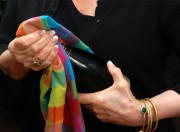





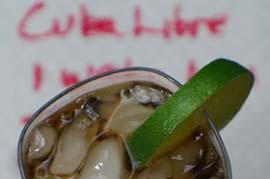
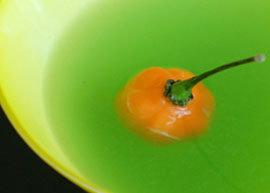



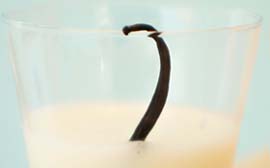

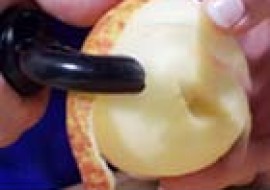
Loved this article and all the behind the scenes information. And we agree with you that Fior D’Italia is a great place! We do miss their old location, though. Why can’t landlords think like chefs? In any case, thanks for this post.
Gianni is my Godfather. I am very proud of him. He knew me since I was born and he was close to my family in the hotel industry. As I child I remember him making amazing ceasar salad. Although not a traditonal Italian dish at all he gave it full Italian flavor with Italian ingredients. He also did it in an entertaining manner which is why I remember dearly. Yes and the gnocchi are great. I try to see him when I am on business in San Francisco. First stop to Fior d’Italia.